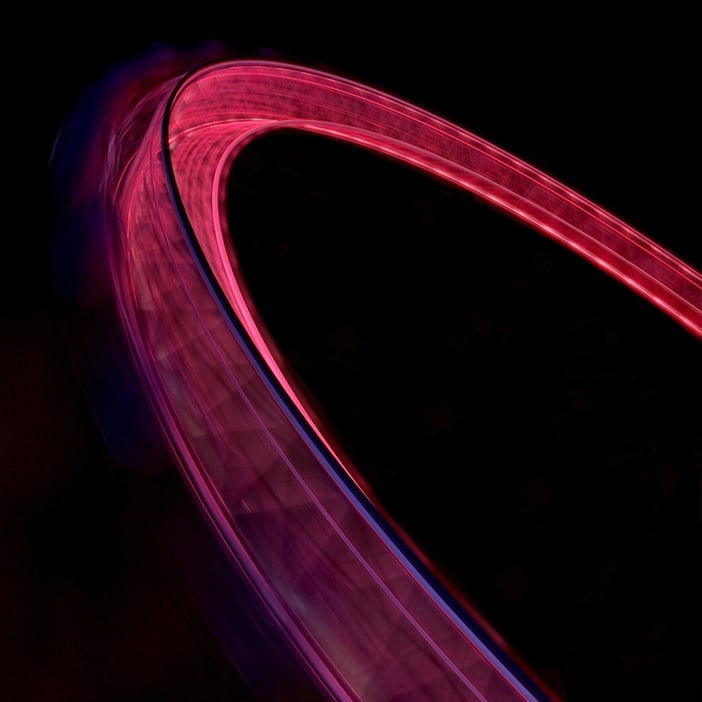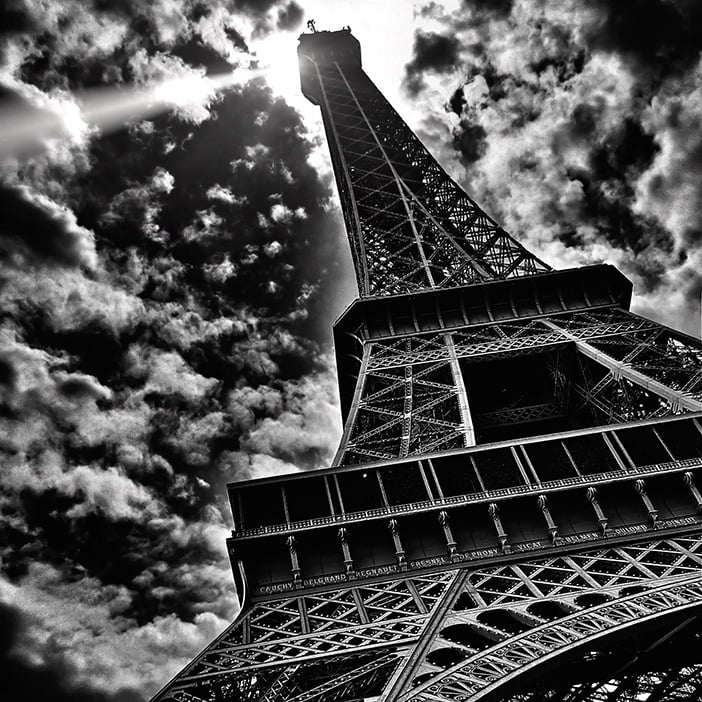Christian Feichtner lives in Vienna, Austria. He has been a photographer for many years and used to work as an event and concert photographer during the 2000’s. Since that time his interests have gravitated towards travel photography and iPhone photography.
Another fascination of Christian’s is abandoned places which feature extensively in his portfolio of images on Instagram.
I caught up with Christian to find out more about his photography, in particular his fascination with abandoned photography and his visit to the Chernobyl exclusion zone which he visited during one of his photography trips.

One of my most recents shots taken during a snow shoe hike at Rax mountain Range in Austria
You have a background in DSLR photography so how did you first discover iPhone photography?
I used the iPhone merely as a low quality snapshot camera since it came out. Then I discovered Hipstamatic and used it for a while to create those old looking photos. Later, during a trip to Las Vegas in 2012, I took more and more photos with my iPhone. One day, I decided my DSLR stuff and the heavy backpack had to stay in the hotel and I started to take photos of Vegas using only my iPhone. Later, as I discovered apps that allowed me to edit my photos I turned completely to iPhone only photography and sold my big camera and accessories.

A shot from my Hipstamatic era back in 2010
What inspires you to take photos with your iPhone?
As strange as this may sound, but my main motivation is because I love to travel light. No more heavy and cumbersome equipment. Previously, I needed a DSLR and notebook computer but now I can do the same thing on a single device which fits into my pockets.

A shot of Wynn @Encore in Las Vegas. I added the clouds using Superimpose app, one of the first retouching apps I discovered a few years ago.
Travel is a big part of your photographic work but you also seem to have a soft spot for abandoned places. What is it about abandoned buildings that fascinates you?
Photographically, it’s the contrast to the designed and styled world we live in. For me, those decayed buildings demonstrate one thing quite clearly: In the end, nature wins – always.

Abandoned Sanatorium in Bellitz, Germany. Abandoned shortly after World War II
Tell us about some of the abandoned places you have visited.
We do have a lot of decayed castles here in Austria that I’ve been to; most notably is castle Dürnstein, where Richard Lionheart, King of England, was held captive in 1192. There are a number of places in and around Berlin, Germany, that I’ve been to such as the abandoned Sanatoriums in Beelitz or a former military installation in Wünsdorf. In Scotland I traveled to see the decayed Elgin Cathedral and Kilchurn Castle. In Bucharest, I strolled through the remains of an abandoned ammunition factory. Finally, during a road trip along the south coast of the U.S. I stopped at Bodie in California, a former mining town that’s kept in arrested decay and Rhyolite near Death Valley. But the most exciting trip was definitely a visit to the Chernobyl Exclusion zone.

Bodie, Ghost town in California
Tell us about Chernobyl, what is it like, is it not a hazardous area to visit?
I did a lot of research before I visited the Chernobyl Exclusion Zone. There are still a number of ‘hot zones’ that are hazardous but many areas are clean. Just listen to the guide (and your dosimeter) and use common sense: Don’t drink or eat anything that you find inside the zone.
For me, visiting the zone was like entering a time capsule where time stood still for the past 30 years.
There are two things about the zone: First, to see how nature develops within 30 years and how fast it takes back structures built by mankind and second, that was the eerie silence in the zone that was sometimes interrupted by the warning sound of the Dosimeter like in the old school where I took this photo:

Gas masks at the old kindergarten in Pripyat, Chernobyl Exclusion zone
What do people need to consider if they are thinking about going to an abandoned place in order to stay safe and legal?
Visiting an abandoned place is exciting but does requires preparation. Do your research about the place you want to visit. All the abandoned places I have visited so far are legally accessible; some require a paid guide as a companion. The guide will ensure you have a great experience while staying safe.
During such excursions I usually wear sturdy shoes that have a thick sole to protect me from stuff like glass and nails on the floor. I also recommend long trousers and a hard wearing jacket that can take it when you brush against any sharp object; for example, that kind of clothing was mandatory when I visited the Chernobyl Exclusion Zone. I also carry a ThruNite TN12 torch and a small first aid kit in such places. And finally, take nothing but pictures and leave nothing but footprints.

Shattered glass on the floor of an abandoned building in Zalyssia in the Chernobyl Exclusion Zone
Tell us about your approach to the composition of your photos. Are there any conscious decisions that you make?
I usually walk around and explore the area near a scene I want to photograph looking for interesting perspectives and ways to frame the main subject. It usually occurs, that I take a dozen photos of the same subject from different perspectives and using different framings. But ultimately, I delete all but the best shot. It’s one of my photographic mantras: ‘Shoot more, keep less’.

This observation is a little off the beaten path at Glacier Point in Yosemite and it provides a nice framing for a well known scene
What apps do you use and is there a process or methodology that you apply to your post production editing?
I also love to ‘travel light’ when it comes to apps. In addition to the iPhone stock camera app I use ProCamera for shooting RAW and low light settings or whenever I need to adjust camera settings manually. For long exposures, I use Slow Shutter Cam and occasionally I use Hydra to create photos up to 32 megapixels. When it comes to editing, I use Adobe Lightroom Mobile to develop RAW photos, Enlight and Pixelmator for retouching and SKRWT to fix perspective distortions.

A 40 second long exposure of the London Eye taken with Slow Shutter Cam App
Do you use any iPhone accessories to take your photos?
As I love to travel light, I limit myself which iPhone accessories I carry. The minimal stuff is a Moment Wide Lens, a magnetic Joby Gorillapod with a Joby Griptight mount and power bank. Sometimes I carry an AmazonBasics Travel Tripod; e.g. when photographing inside abandoned places.

Skogafoss in Iceland, taken with a Moment Wide Lens
What advice would you give people who are looking to take better photos with their smartphone?
My advice would be, as with any other camera, is to learn how to operate the smartphone camera; find out where it excels and where it has its limits. Next, learn what ISO, shutter speed and aperture mean, if and how you can adjust them on your smartphone camera, and which effect they have on your photos. For example, you can’t adjust aperture on iPhone, which in turn has implications on e.g. landscape photos. Then, grab your smartphone, go out and take photos applying what you’ve read about ISO, shutter speed and aperture. Finally look for apps that support your kind of photography and rather be a master of one app than a jack of all trades [apps].

ProCamera is my favourite app when I need to photograph special settings. It has a LowLight mode and allows adjustment of ISO and shutter speed
Tell us about three of your favourite photos and the story behind them
Last View in the Chernobyl Exclusion Zone
We’ve been told that a few people refused to leave the exclusion zone after the incident in 1986. On our way back from the zone we had to stop twice and pass full body scanners to see if any of our clothing was contaminated. After we passed the scans, we waited outside. I started talking to the bus driver and asked him about the people who refused to leave the zone after the incident and where to find them. He said I should go around the bus. I can see two of them there.
Pigeon Swarm at Atheneul Roman in Bucharest
Once I arrived on the scene to photograph the building, I saw the pigeon swarm. There was simply too much of them to scare them away. Even two dogs that were running around in the park near the building couldn’t scare the pigeons way. So I decided to make them part of the photo. I waited for nearly 30 minutes until the swarm flew over the building exactly the way I pictured it. I hit the shutter release button and kept it pressed, which triggered burst mode and helped me to get this shot.
Eiffel Tower Black and White
In 2013 I was asked to give a session on how to take and edit pictures with an iPhone during a photography workshop. For the retouching part I used a photo of the Eiffel Tower that I took earlier as a Snapshot and demonstrated how to use Superimpose to add the clouds, Lensflare to add the searchlight at the top.
Where can people connect and follow you online?
www.squics.com | Instagram | Facebook | Flickr









Fantastic images! Thanks for sharing!
This was great thank you for sharing
Great article. Love your work